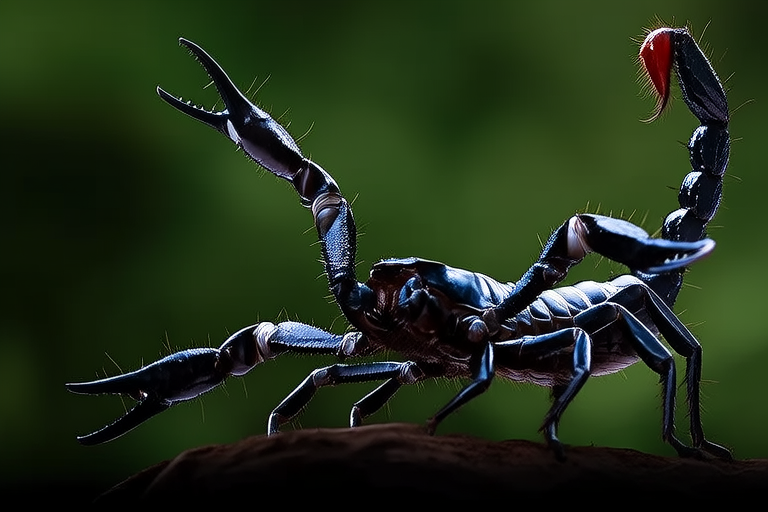Unveiling the Mysterious Heterometrus Spinifer: Everything You Need to Know
In the dense jungles of Southeast Asia, there exists a creature that has long captivated the imagination of both scientists and locals alike: the Heterometrus spinifer. This fascinating scorpion, known for its distinctive physical attributes and enigmatic behavior, plays a crucial role in its ecosystem. Let’s delve into the world of this mysterious arachnid, uncovering its secrets and shedding light on what makes it such an intriguing subject of study.
Physical Characteristics
The Heterometrus spinifer is a medium-sized scorpion, typically ranging from 8 to 12 centimeters in length. Its most striking feature is the presence of spines along the dorsal side of its tail, which gives it its name. These spines serve multiple purposes, including defense against predators and possibly aiding in mating rituals. The coloration of the Heterometrus spinifer varies from dark brown to almost black, providing excellent camouflage within its natural habitat. Its body is segmented, with eight legs and two large pincers at the front. The eyes, located on the cephalothorax, are sensitive to low light conditions, allowing the scorpion to navigate efficiently even during the night.
Habitat
The Heterometrus spinifer thrives in humid, tropical environments, making it common in rainforests, mangrove swamps, and other moist areas across countries like Thailand, Malaysia, and Indonesia. It prefers habitats with plenty of hiding spots such as under rocks, logs, or leaf litter. This preference for secluded areas contributes to its elusive nature, often making it difficult for researchers to study its behavior in detail.
Diet
This nocturnal predator feeds primarily on insects, though it may also consume small vertebrates if given the opportunity. Using its keen senses and powerful pincers, the Heterometrus spinifer hunts by ambushing prey that ventures too close to its hiding place. Once caught, the scorpion injects venom through its stinger, paralyzing the victim before consuming it. Despite being venomous, the toxicity level of its venom is relatively low compared to other scorpion species, posing little threat to humans unless provoked.
Behavior
The behavior of the Heterometrus spinifer is marked by stealth and caution. During the day, it remains hidden in its burrow or beneath cover, emerging only after sunset to hunt. When threatened, it adopts a defensive posture, raising its tail above its body as a warning signal. If further provoked, it can deliver a painful sting, though fatalities are extremely rare due to the mild nature of its venom. Mating rituals involve complex courtship dances performed by males, during which they use their pedipalps (front appendages) to stimulate females.
Unique Traits
One of the most remarkable aspects of the Heterometrus spinifer is its ability to adapt to various environmental conditions. Its resilience allows it to survive in diverse ecosystems, from coastal regions to inland forests. Another unique trait is its reproductive strategy; females carry their eggs internally until they hatch, after which they give birth to live young. This method ensures higher survival rates for offspring compared to egg-laying species.
Role in Ecosystems
The Heterometrus spinifer plays a vital role in maintaining ecological balance within its habitat. As a top predator, it controls insect populations, preventing overgrazing and promoting plant growth. Additionally, its presence serves as an indicator of healthy ecosystems, as declines in scorpion numbers could signify environmental degradation. By studying these creatures, we gain valuable insights into broader ecological processes.
Interactions with Humans
Despite its fearsome appearance, encounters between humans and the Heterometrus spinifer are generally harmless. Locals often coexist peacefully with these creatures, viewing them more as curious neighbors than threats. However, there have been instances where individuals accidentally disturbed nesting sites or provoked scorpions, leading to minor injuries. Education campaigns aimed at fostering respect and understanding towards wildlife can help prevent such incidents.
Conservation Status
Currently, the Heterometrus spinifer does not face immediate extinction risks according to IUCN Red List classifications. Nevertheless, deforestation and urbanization pose long-term threats to its survival. Conservation efforts focus on preserving intact forest patches and raising awareness about the importance of biodiversity. Continued monitoring programs will be essential to track population trends and address potential challenges early.
Ongoing Research and Myths
Scientists continue to investigate various aspects of the Heterometrus spinifer’s biology, including venom composition and potential medical applications. Recent studies suggest that certain compounds found in its venom might hold promise for pain management treatments. Meanwhile, local folklore abounds with tales attributing magical powers or protective qualities to this scorpion. While these stories add charm to cultural heritage, they underscore the need for accurate information dissemination.
In conclusion, the Heterometrus spinifer remains shrouded in mystery yet offers endless fascination for those willing to explore beyond surface-level perceptions. Through rigorous scientific inquiry and collaborative conservation initiatives, we can unlock deeper truths about this remarkable species while ensuring its continued existence for future generations.
